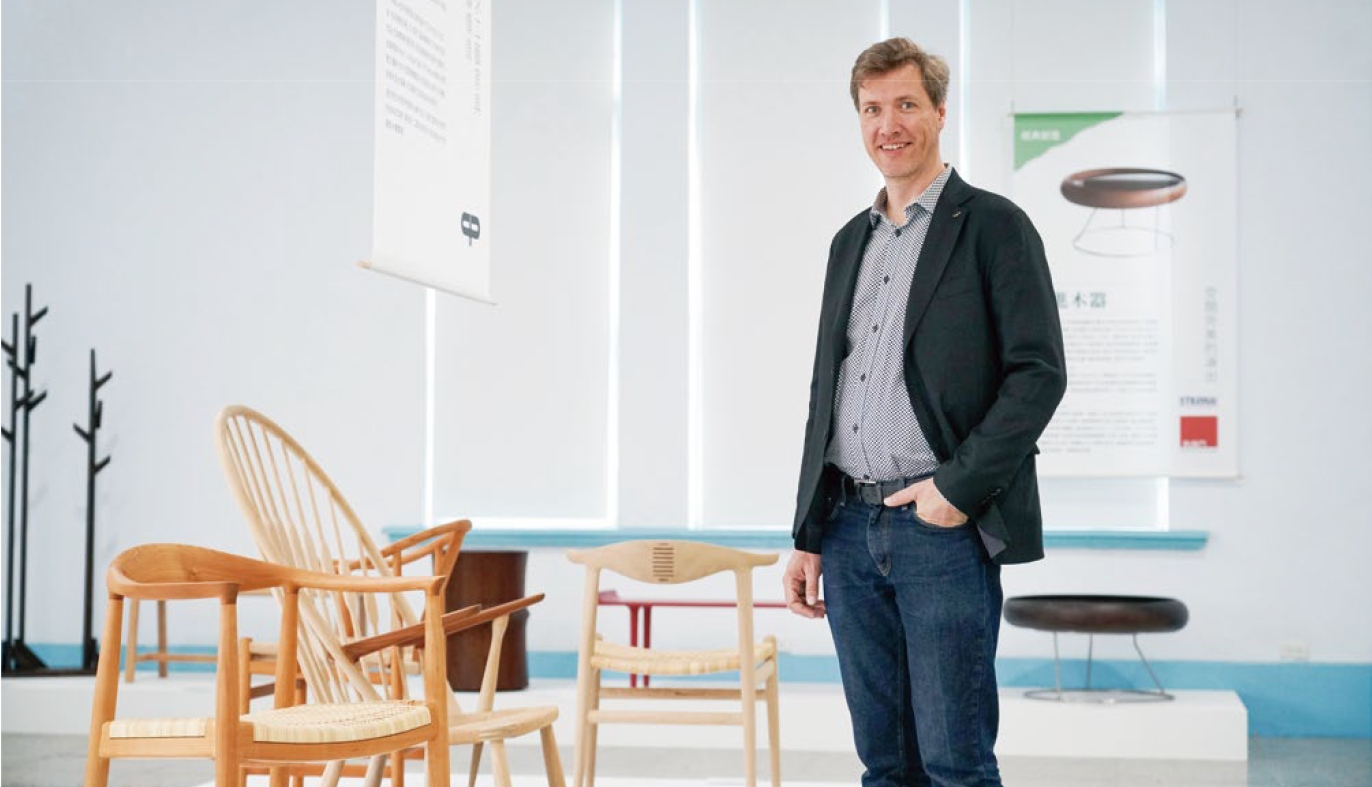Sustainable Development of the Furniture Industry
Kasper Holst Pedersen / CEO and third-generation chief craftsman of PP Møbler
"Sustainable Development of the Furniture Industry"
Crafting a Future of Quality and Balance
One might question the significance of design in a highly engineered world, and the relevance of craftsmanship in a modern society.But design is not just about following trends and creating pleasing aesthetics; it is fundamentally important, as it shapes our living spaces, determining the usability, aesthetics, and durability of the objects that fulfill our basic needs and create a quality home experience. It is, in essence, the architect of the quality of our lives and, to some extent, our impact on the environment. Craftsmanship is a way of making things manually with experienced hands. In many ways craftsmanship can be regarded as an opposition to industrialization, so as the world has become increasingly industrialized, it is only natural that craftsmanship will struggle and loose relevance. Today however, it should be clear to all of us that we face a myriad of environmental challenges due to our industrialized way of living. For too long, we have indulged in fleeting trends and disposable goods. As the industrialization era unfolded, propelled by the possibilities of fossil fuels, humanity became stuck in a relentless cycle of consumption, leaving behind a trail of waste and environmental degradation. Today, as the Earth's resources face unprecedented strain, the call for responsible living resonates louder than ever.
Plastics and Beyond
No doubt, plastics have played a critical role over the past 70 years’ advancement of our society. But in my opinion, we can safely say that if we are to live in some kind of balance with nature, we must limit the use of fossil fuels, and any of their chemical by products. We must stop using plastics unless absolutely necessary. And what about metals? Well, in their clean state the most common metals like iron and aluminum pose no threat to our environment. However, metal requires a lot of energy to process, so until the day, when we have limitless supply of clean energy, we will have to be careful how we use metals. Beyond the immediate environmental impact, we must consider the long-term consequences of our material choices. While plastics have undeniably facilitated modern advancements, their persistent presence in landfills and oceans is a stark reminder of the cost we didn’t pay, when we produced and consumed the products. It is true that plastics can be recycled, but it requires a lot of resources and new plastics in the process, and as plastics are not biodegradable, we would only putt off the inevitable environmental consequences. In the quest for sustainability, it becomes evident that we need to revise our dependency on petrochemicals. Our overdependence on cheap, easily producible materials must give way to a more thoughtful approach — one that embraces the harmony of nature.
Utilizing Natural Materials
In the realm of sustainability, the obvious choice emerges — vegetable fibers and plant materials. Among them, wood stands tall as the most crucial natural resource for construction projects. Its minimal energy requirement for processing and endurance across generations make it the ideal and, to some extent, the only sustainable choice. Yet, the handling of wood and plant materials in production is not ensuring a perpetual supply of raw materials without compromising the delicate balance of ecosystems. As all living organisms, trees have a limited lifespan and will eventually fall
and decay, and harvesting one tree will make more space for the surrounding trees to flourish even more. Harvesting with wisdom and care will make our forests an eternal clean resource.always a straightforward industrial process; it demands craftsmanship. Craftsmanship, a seemingly endangered art in the face of petrochemical efficiency, enables us to use plants in their most natural state and therefore becomes the key to sustainable production. The varying properties of plant materials necessitate manual expertise in production, and each piece becomes a unique testament to the hands that crafted it.
Sustainable Forests is a Simple Solution
A forest, when harvested selectively, provides a constant supply of timber over time while,serving as a haven for biodiversity and wildlife to maintain a healthy ecosystem. We need to respect the pace in which the forests can regenerate, and only take what nature can provide. In order to ensure that we never exhaust the forests, we need to make durable products – preferably products that will last for as long, as it takes a new tree to grow. This too, demands craftsmanship. Sustainable forestry management emerges as a foundation or future responsible living. It's not just about harvesting timber; it's about fostering a symbiotic relationship with nature. Selective harvesting allows forests to regenerate naturally,Craftsmanship in Balance The pressure on craftsmanship over the past century, overshadowed by the efficiency of petrochemical production, is apparent. Initially cheaper, the long-term consequences of this production method have become evident in environmental intoxication and degradation. The importance of investing in products made to last from natural materials, shaped by craftsmanship, emerges as a pathway to achieving balance with nature. Choosing a natural solution over a petrochemical one should evolve into timeless principles of good conduct in production. For instance, abandoning the use of petrochemical lacquer in favor of soap or natural oils and waxes allows wood to age gracefully and return to nature seamlessly.
A Serious Game of Design
I am greatly honored to have been invited to participate in the first design event of the Daxi Wood Art Ecomuseum, and I was amazed by the quality and the variety of submissions to the design competition. It is a true testament to a thriving culture of craftsmanship in Taiwan, and the event offers an important forum for design development.
Design is a creative process, and it is necessary to conduct experiments to test the boundaries of the material properties while searching for a way to serve the purpose of the product well. But we also must respect the fact that the objective of the experiments is to ultimately find a way to make durable and practical products from natural materials. As Hans J. Wegner once said: “We must play. But we must play a serious game.”
Anyone who has tried to make a chair out of solid wood will know that it is a significant challenge if you want it to be both comfortable, durable, and elegant. At PP Møbler, we have conducted numerous experiments through the years and gained a broad spectrum of knowledge and experience. Still, our production is based almost entirely on designs by the great Danish modernist master Hans J. Wegner, as these designs have proven to stand the test of time and stay aesthetically and functionally relevant, while obviously remaining durable, comfortable, and elegant.
I strongly believe that our products will continue to be relevant and that they will stand as a reference for good sustainable design in the future. But I also believe that we must continue the search for new design with a particular focus on wood and other natural materials. It is more relevant than ever, if we are to create a sustainable development.
To me, one of the most interesting aspects of design is the comfort and ergonomics of products in general, and chairs in particular. Because we often spend much time sitting in chairs and it is so close to our body, it seems like a design challenge of essential importance. And I will dare to argue that despite the enormous number of chairs designed, there are surprisingly few chairs that offer a genuinely ergonomic support for the human back. Modern chairs in solid wood of high quality, with good ergonomics and strength, are in fact rare to find. And no wonder, since the furniture industry has been so industrialized for so long, and it is not easy making such a good chair. Even Wegner made chairs with bad ergonomics, but at least he learned, and through careful studies, he developed his designs for the better – in some cases, he created true masterpieces in solid wood.
Design for Tomorrow
Let us continue to support and promote good craftsmanship and believe in the resilience of nature and the prospects of a sustainable legacy. We must make a future based on quality, endurance, and responsibility. This requires insight, thorough work, and respect for our resources.
A heartfelt thank-you to The Daxi Wood Art Ecomuseum for fostering the development of craftsmanship and design for tomorrow. Let's hope this endeavor gives rise to many exceptional products from natural materials, boasting qualities yet to be discovered. I believe many great designs are still to come, and they can be made in true balance with nature.

▶ PP Møbler Official Website https://pp.dk/
▶ This article is included in "The First Daxi International Wood Furniture Craft and Design Competition Exhibition Journal". We warmly invite you to purchase for further reading.
▶ Copyright and Licensing Statement:
All content published on this page—including but not limited to text descriptions, images, software, audio recordings, videos, and other information—is protected under copyright law. Without prior authorization, no part or whole of the website's content may be reproduced, publicly broadcast, publicly screened, publicly performed, publicly transmitted, or adapted in any manner governed by current copyright legislation. However, actions that constitute fair use under applicable copyright law are not subject to these restrictions.

